
|
Bracket Fungus
Bracket fungi (Ganoderma) normally attack dead tree trunks but they
can also be found growing on living trees which have been "wounded".
They stick firmly to the wood substrate. Bracket fungi are
generally not edible because they are hard and tough, but one
species, Ganoderma lucidum, is cultivated to
produce Ling Zhi, a food supplement valued for its medicinal and tonic properties.
|

|
Bracket Fungus
Some insects include fungi in their diet. I once saw a grasshopper eating a small mushroom.
Several species of Fungus Beetle (Eumorphus) feed on the spores of bracket fungi. Many insect larvae
gathered on the underside of this large bracket fungus, presumably to feed on its spores.
|
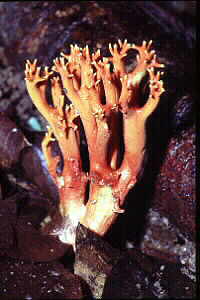
|
Coral Fungus
This coral fungus (Ramaria sp.) grows in very damp areas that are well-shaded
by the forest canopy, for example near water courses in the lowlands. The specimen
shown here is quite young, but older specimens are highly branched and resemble corals,
hence the common name.
|
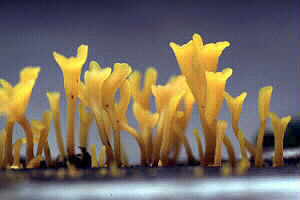
|
Jelly Fungus
This jelly fungus was found growing on a log. The basidiocarps, standing one centimetre
to 2cm high, are conical or club-shaped and have a bright yellow colour. The species is
probably Guepinia spathularia (Ascomycotina).
|

|
Agaric Fungus
This cluster of subtly coloured agaric fungus nearly escaped my notice. It was growing on
sloping ground lightly covered with some leaves and was almost the same colour of the soil
and dry leaves. I cleared the leaves for this picture (and replaced them later). This
species probably belongs to the genus Termitomyces.
|

|
Gills of Fungus
Many agaric fungi have "gills" on the underside of their fruiting
bodies. Often, it's difficult to photograph the underside
without removing them from the substrate. I photographed this specimen in situ; it
was growing on a broken tree branch about one metre
(several feet) above a forest trail.
|
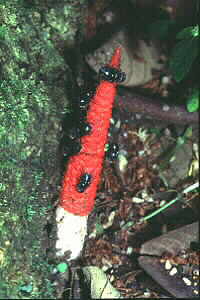
|
Stinkhorn Fungus
Stinkhorn fungi emit an unpleasant odour, like that of rotting meat or carrion,
which attracts flies looking for food. The fungal spores stick to the flies' legs and
bodies, and thus the flies help to disperse the spores.In this picture, some blow
flies (Chrysomyia sp.) have settled on a red stinkhorn fungus (family Phallaceae).
|
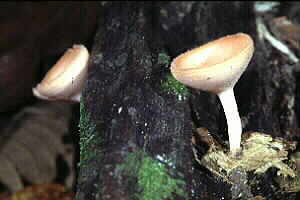
|
Cup Fungus
Two species of Cup Fungus, Cookeina sulcipes (shown here) and C. tricholoma,
are found in Malaysia. C. sulcipes has "smooth" cups with colour ranging from
peach to light orange, while C. tricholoma has hariy cups with colour ranging from
a very pale shade of pink to light red.
|
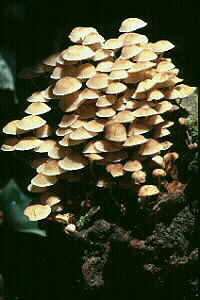
|
Ink Cap Fungus
This ink cap fungus (Coprinus) has fruiting bodies which appear like a mass of tiny
umbrellas (with a diameter of less than 2cm). I found it growing on the broken tap root
of an uprooted tree. The matured caps of this type of fungus dissolve into a "gooey" black
mass containing the spores.
|
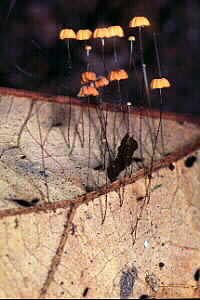
|
Parasol Fungus
Shaped like tiny umbrellas of a half-centimetre across, these mushrooms are found in leaf
litter. They have a leathery texture, and the long, thin stalks are also tough and wiry.
The species shown here (Marasmius sp.) grows on dead leaves. Like other fungi in the
tropical rainforest, Marasmius spp. are efficient decomposers, recycling nutrients
in dead leaves.
|
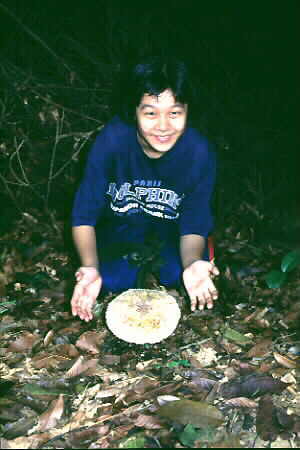
|
Big Toadstool
I found this toadstool growing in dry leaf litter in a forest near Kuala Lumpur (it was a dry period of the
year around February). I posed my daughter behind the toadstool for this picture to give an indication of
its size. It was roughly 20cm (8 inches) in diameter, with a stalk above the ground of about 10cm (4 inches).
|

